Top Surfing Destinations for Beginners to Explore
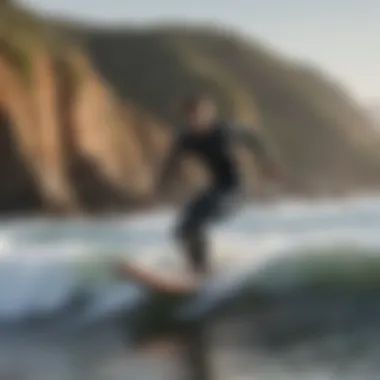
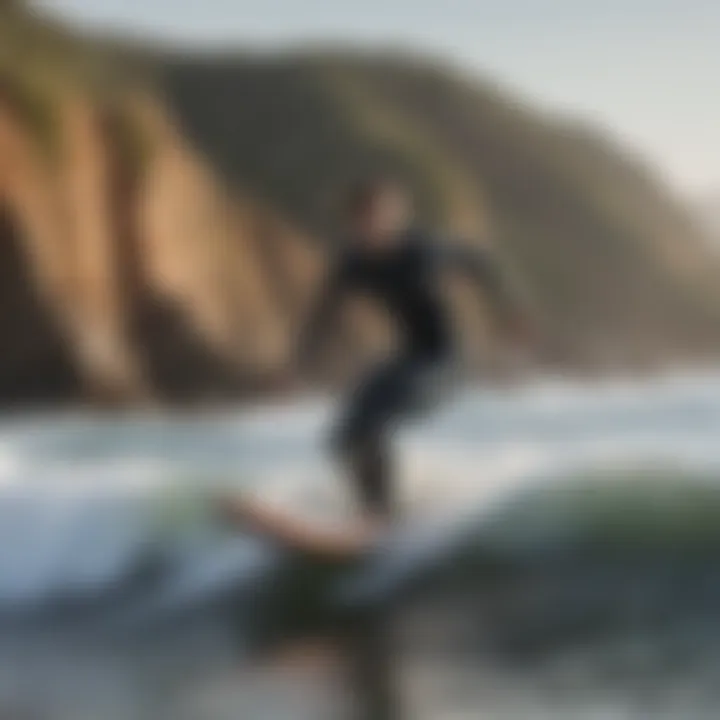
Intro
Embarking on a surfing adventure can ignite a spark unlike any other. For beginners, the thrill of catching your first wave can be both exhilarating and daunting. It’s a dance with the ocean, where every swell and ripple beckons you to try and master its rhythm. As surf culture permeates various corners of the globe, knowing which destinations are particularly welcoming to novices is essential. This guide aims to illuminate those spots, ensuring you step into the vibrant world of surfing with a clear path ahead.
Before you dive in, it’s crucial to grasp some fundamental techniques and skills that lay the groundwork for your surfing prowess. Likewise, safety measures and the right gear are paramount for a fruitful experience. With clarity on these elements, novice surfers can wade confidently into their aquatic pursuits, ready to embrace what the waves have to offer.
Techniques and Skills
Surfing, at its core, is about feeling the water beneath your board and finding your balance amidst the shifting tides. Mastering the basics is what will set you on a course for future success, so let’s breakdown some key techniques.
Fundamental Techniques for Beginners
- Paddling: A crucial component of surfing is learning how to paddle efficiently. Start lying prone on the board, using alternating hand strokes while keeping your body centered and streamlined.
- Pop-up: This is the transition from lying on your board to standing. Start from a lying position, and with a swift motion, push your hands down to lift your torso while bringing your feet under you into a squat position.
- Balancing: Focus on maintaining your center of gravity. Bend your knees slightly to keep your stance stable and look ahead rather than down at your feet.
Advanced Skills for Experienced Athletes
Once you’ve nailed down the fundamentals, it’s time to refine your skills and explore more complex maneuvers.
- Carving Turns: Begin practicing subtle turns in the surf. Shift your weight to your heels or toes, depending on the direction you want to go.
- Duck Diving: This technique allows you to navigate through waves while paddling out. Push your board down as a wave approaches, then dive underneath, allowing the wave to pass over you before surfacing on the other side.
"Mastery of the ocean isn’t about knowing every wave; it’s about understanding your own rhythm within it."
Safety and Gear
Surfing is a joyous pursuit, but it does come with its risks. Understanding safety protocols and having the right gear can make all the difference.
Essential Safety Measures in Watersports
- Know Your Limits: Start in smaller waves suitable for beginners; pushing oneself in challenging conditions can lead to accidents.
- Stay Aware of Conditions: Before hitting the waves, check for tide charts and potential riptides. Local surf shops often provide insights on the best times to surf.
Gear Reviews and Recommendations
When it comes to gear, having the right equipment is non-negotiable. Here are some essentials for novice surfers:
- Surfboard: For beginners, a soft-top longboard is typically the best option as it provides stability and reduces the chance of injury during wipeouts.
- Wetsuit: Depending on your geographical location, a wetsuit might be necessary for warmth and protection against the elements. Look for a suit that fits snugly, allowing for flexibility and movement.
- Leash: This safety accessory secures your board to your ankle, preventing it from drifting away after a wipeout.
Arming yourself with knowledge about techniques, safety, and suitable gear will pave your way to becoming a confident surfer. In the upcoming sections, we’ll explore prime surfing destinations tailored for beginners, ensuring you make the most of your surfing vacation.
Preface to Surfing for Beginners
Diving into the world of surfing can feel daunting for many newcomers, yet understanding the foundational aspects of this surf culture is crucial. Novice surfers are often overwhelmed with information about waves, tides, and the proper techniques required to ride a board successfully. By breaking down the basics, this section aims to ease those apprehensions. Beyond just the physical act of surfing, it's an exhilarating journey that opens doors to a vibrant community and fresh experiences.
Understanding Surfing Basics
At its core, surfing is all about riding waves on a board. It might sound simple, but there’s a lot going on under the surface. First, there's the board itself. Beginners usually start with longboards, as these provide better stability, making it easier to balance and catch waves. Learning how to paddle out, position the board, and ultimately stand up takes practice and patience.
The ocean isn't the same every day—tides shift, winds fluctuate, and waves vary in size and power. For a beginner, familiarizing yourself with these factors is key. Understanding which conditions are ideal for learning can prevent mishaps and create an enjoyable environment. Make no mistake, safety is a priority here. Learning about rip currents and how to navigate safely around surfers who are more experienced is invaluable. In short, grasping these fundamentals not only enhances your surfing journey but also ensures that it remains enjoyable and secure.
Importance of Choosing the Right Destination
When it comes to surfing, not all beaches are created equal, especially for beginners. Selecting the right destination can make or break a vacation; the last thing you want is to be battling overpowering waves in a crowded spot. Ideally, you should look for locations with gentler waves and a welcoming atmosphere. Beaches with sandy bottoms, as opposed to rocky ones, provide a safer surfing environment and reduced risk of injury.
Moreover, accessibility is another critical factor. Many surfer-friendly locations boast surf schools and rentals nearby, making it easier for novices to take lessons and acquire necessary gear. A supportive community of local surfers can be found in places like Malibu and Waikiki, where the learning environment is enriched with shared experiences and camaraderie.
"Choosing the right surfing destination can pave the way for a fulfilling and confidence-building experience."
Whether you're looking to island-hop through Hawaii or hit up the iconic beaches of California, take the time to consider what each place offers in terms of conditions and local support. Your surfing experience, as a beginner, should feel like a thrilling journey rather than an unforgiving challenge, so prioritize those friendly waves and welcoming locals.
Criteria for Selecting Beginner-Friendly Surf Destinations
When venturing into the world of surfing, the choice of destination often shapes the overall experience. Newcomers to the surf scene need to focus on a few essential criteria when selecting their ideal surfing destinations. Factors such as surfing conditions, available resources, and local amenities can significantly influence a beginner's surfing journey. Each of these elements plays a crucial role in ensuring that novices not only feel comfortable but also enjoy their time in the water.
Surfing Conditions and Safety Considerations
Waves can be as unpredictable as the weather. For beginners, selecting locations with manageable wave conditions is vital. Gentle waves give novices the chance to practice balancing on the board without the constant threat of wipeouts. Proper conditions usually mean smaller swells; thus, spots like Waimea Bay in Hawaii can be omitted during big wave season, while calmer areas such as Waikiki Beach present safer alternatives.
Additionally, safety cannot be overlooked. Many beaches have lifeguards on duty and established safety measures for learners. Before hitting the waves, beginners should familiarize themselves with local signs indicating the currents, tides, and riptides. The phrase "catching a wave" should be synonymous with joy, not fear. Choosing surf destinations that boast a solid reputation for beginner safety can make all the difference.
Availability of Surf Schools and Rentals
The presence of surf schools and rental facilities can turn an exhilarating dream into a reality. Surf schools offer expert instruction, catering specifically to those who've never set foot on a board before. They can guide beginners through everything from paddling to popping up on the board, ensuring that novices build confidence at a steady pace. Locations like Malibu offer numerous schools where instructors are equipped to lead first-time surfers.


When it comes to gear, renting surfing equipment is often a wise choice for beginners who are not quite ready to invest in pricey boards and wetsuits. Many surf towns have shops that not only offer rentals but also provide gear tailored to novices. This can save both time and money and allow beginners to explore different types of boards—finding what feels most comfortable.
Local Amenities and Accommodations
Beyond the surfable waves, the local environment plays an undeniable role in a surfer's experience. Amenities such as restaurants, restrooms, and first-aid stations can make a surfing trip far more enjoyable. A destination should support a lifestyle that revolves around surfing, including casual dining options and nearby entertainment suited for both surfers and their families.
Additionally, accommodation options should cater to the budgets of novice surfers. From cozy hostels to family-friendly resorts, the right lodging can enhance the experience. Proximity to the beach can make all the difference for those long days spent surfing and unwinding under the sun.
Choosing a destination that combines these criteria creates a more supportive and enriching surfing environment for beginners. This allows them to focus on the waves and their technique, while also enjoying the beauty and culture of the surrounding area.
Top Surfing Destinations for Beginners
Knowing where to go can make all the difference when you're starting your surfing journey. Some places have perfect conditions tailored for novices, making it easier to catch the first wave and build confidence. The benefits of selecting the right destination are plentiful: favorable weather, sturdy surf schools, and a friendly atmosphere are elements every beginner should look out for. This section dives into popular spots, offering insights into why they stand out.
California: A Hub for Learners
California serves as a beacon for budding surfers, boasting a diverse array of surf breaks suitable for those just starting. Its beaches, characterized by gentle waves and expansive coastlines, make learning feel less daunting and more inviting.
Key Locations: Malibu, Huntington Beach
Malibu is not just iconic for its picturesque views but also for the surf-friendly waves it presents, particularly in summer. The gentle swells here make it accessible for learners looking to get a hang of standing up on a board. Huntington Beach, on the other hand, is often dubbed "Surf City USA," and for good reason. It has long stretches of sandy beaches and consistent wave patterns beneficial to novices. Both locations offer safe environments, but it is wise to visit during off-peak times to avoid crowd congestion, which might be intimidating for new surfers.
Local Surf Schools
The presence of reputable surf schools is another keystone for California's appeal to beginners. Many schools around Malibu and Huntington Beach provide comprehensive lessons tailored to novices. Instructors are often well-trained and promote safety while ensuring that their students gain a valuable foundation in the basics. Additionally, local surf shops offer rental equipment, making it easier for beginners to jump in without heavy investment upfront. The only downside might be the fluctuation in class sizes; larger groups may lead to less individual attention.
Hawaii: The Birthplace of Surfing
Hawaii's reputation as the birthplace of surfing lends an air of authenticity to the experience for beginners. The island's diverse locations foster an understanding of both surfing techniques and cultural respect.
Best Spots: Waikiki, Maui
Waikiki’s relatively flat waters create an excellent setting for beginners trying to catch their first set of waves. The friendly vibe and community focus make it a great spot where you can often see multiple learners alongside seasoned surfers. Maui also boasts beautiful beginner-friendly breaks, especially at Lahaina, where gentle waves come ashore. Each location provides novices with unique learning environments, though it's essential to consider the local surfing rules and etiquette before hitting the water.
Cultural Aspects of Surfing
Engaging with Hawaii's surfing culture is invaluable for any beginner. Understanding the significance of surfing to the locals adds depth to the learning experience. Novices are often encouraged to learn not just technique but also the traditions tied to the sport. This engagement may include observing beginners' experiences, often rich with stories of respect towards the ocean. The downside here is that sometimes beginners might feel overwhelmed by the deeper cultural aspects, but a willingness to learn usually fosters understanding over time.
Australia: An Ideal Surfing Paradise
Australia is another top destination that draws aspiring surfers from across the globe, showcasing a variety of beaches with different wave conditions.
Popular Beaches: Bondi, Byron Bay
Bondi Beach, with its iconic status, often fills up with both surfers and tourists, making it a great place to learn while soaking in the local atmosphere. Conversely, Byron Bay offers a more relaxed vibe, catering to those who want to escape the busier spots while still enjoying quality waves. Both have surf schools and trained instructors who contribute to a supportive learning environment.
Community and Events
Local communities in Australia are vibrant and often host surfing events that include competitions and friendly gatherings. Engaging in these events is a fantastic way for beginners to mingle and learn from seasoned surfers. However, it is worth noting that during events, certain spots may get crowded, so timing your visit is crucial to ensure a more personal learning experience.
Portugal: Europe's Surf Destination
Portugal has been gaining popularity as an exceptional spot for novice surfers, offering uncrowded beaches and inviting swells.
Coastline Highlights: Ericeira, Lagos
Ericeira is famous for its stunning formations that create user-friendly waves ideal for learning. Lagos, with its picturesque cliffs, presents beautiful settings and clear waters, boosting the overall experience for novices. Both locales are easy to navigate, although some might find the crowds gathered during peak seasons a bit daunting.
Learning Environment
The local surf schools emphasize a relaxed atmosphere that encourages beginners to take their time learning. Here, you can often find a mix of international and local instructors who bring unique perspectives to surfing. It's essential to check availability during busy seasons, as they tend to fill up quickly, leaving some learners with limited options.
Costa Rica: Surf and Nature Combined
Costa Rica offers a rugged aesthetic that’s equal parts surf and stunning natural beauty, drawing eco-conscious surfers and nature lovers alike.
Key Places: Tamarindo, Nosara
Tamarindo is well-known for its lively surf culture, where novices can comfortably surf under the watchful eye of skilled instructors. Nosara presents a more serene backdrop, encouraging a laid-back approach to learning how to surf. Each place has its unique vibe and charm worth considering.
Eco-Friendly Approach
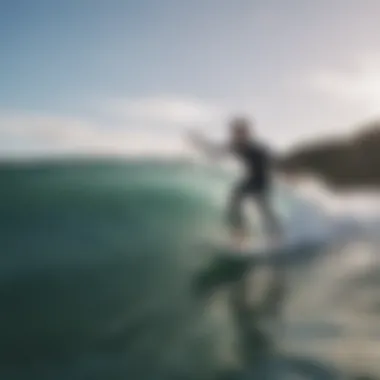
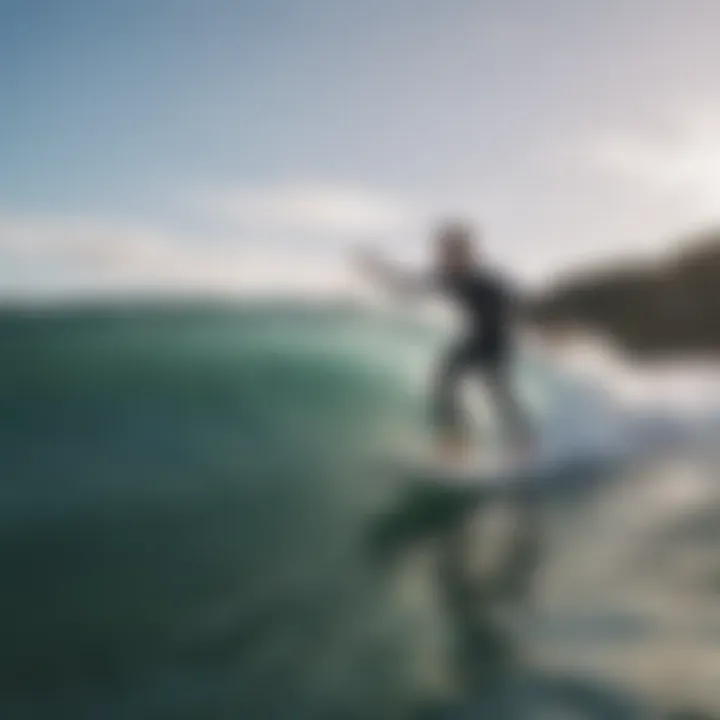
The commitment to eco-friendliness in Costa Rica enhances the surfer's experience. Many local businesses rely on sustainable practices, attracting those who care about protecting the environment. While the commitment to sustainability is a huge plus, the cost of eco-friendly options may sometimes be higher than traditional setups, so budgeting wisely is essential.
Understanding Surfing Equipment for Novices
Surfing is not just about riding the waves; it's also about understanding the equipment you'll be using. For beginners, diving into the world of surfboards, wetsuits, and essential safety gear can feel like learning a new language. However, comprehending these elements is crucial for a successful and enjoyable surfing experience.
When you’re just starting out, your equipment can make all the difference between a fun day on the water and a frustrating one. The right board, proper safety gear, and an understanding of how they work together can pave the way for a smoother learning curve and a more immersive experience in the surfing lifestyle.
Choosing the Right Board
The surfboard is the heart of the surfing experience. As a novice, selecting a board tailored to your skill level is vital. Generally, beginners are encouraged to opt for a soft-top board. There are several reasons why this type of board is a solid choice:
- Stability: Soft-top boards provide a larger surface area, making it easier to balance and catch waves.
- Safety: The foam construction minimizes the risk of injury, both to yourself and to others in the water.
- Good for Paddling: The buoyancy helps beginners paddle and get into waves without too much effort.
Moreover, the length of the board also matters. Longer boards, around 8 to 9 feet, can be more forgiving. They allow for easier paddling and catching waves, providing a more enjoyable introduction to surfing.
Essential Safety Gear
Safety is paramount when it comes to any water sport, especially surfing. As a newcomer, there are a few pieces of safety gear that should be on your checklist:
- Wetsuit: A wetsuit not only keeps you warm in cooler waters but also provides some buoyancy and protection from the sun and possible scrapes.
- Leash: This is the cord that attaches your board to your ankle, ensuring you won't lose your board to the waves. It's an essential safety feature that keeps both you and others safe.
- Helmet: While not as common for surfing as it is in other water sports, a helmet can offer added security, particularly in crowded surf spots.
Additionally, getting familiar with local surf etiquette can protect you and others. Understanding how to share the waves, respect others’ space, and manage your comfort and safety is just as critical as the gear itself.
"The right equipment is like a good foundation; it supports your growth and confidence in your surfing journey."
In summary, realizing the importance of understanding surfing equipment lays a strong groundwork for your journey into surfing. Choosing the right board and ensuring you have proper safety gear will not only enhance your learning experience but also make sure you enjoy every session in the water.
The Learning Process: Surfing Lessons
When embarking on your surfing adventure, taking lessons is not just beneficial, it’s essential. The learning process acts as the backbone of your surfing journey, offering foundational knowledge and skills that can make or break your initial experiences in the water. Learning from experienced instructors helps ensure that you understand the technical aspects of surfing, while also giving you insight into the local surf culture and etiquette. This guidance is not just about catching waves; it’s about building confidence, establishing safety awareness, and forging connections within the surfing community.
What to Expect in Surfing Lessons
Surfing lessons usually begin on the beach, where instructors cover the basics. Here, you can expect to learn important concepts such as:
- Ocean Awareness: Understanding tides, currents, and wave patterns.
- Proper Techniques: Learning how to paddle, pop up on the board, and balance while riding waves.
- Safety Protocols: Knowing how to fall safely and what to do in emergency situations.
These lessons can vary in structure, but they generally include a mix of theoretical and practical components. The instructor may start with demonstrations and move to exercises aimed at getting you comfortable in the water.
"The only thing standing between you and the beautiful ocean is a little bit of courage and some solid training."
In most cases, you will use a soft-top board, which is more forgiving for beginners. This type allows you to focus on your balance and technique without worrying too much about hard edges that can cause injuries.
The Importance of Consistent Practice
Surfing isn’t something you master overnight. It requires consistent practice to develop muscle memory and refine your technique. Regular sessions in the water help solidify the skills you learn in lessons and can make quite a difference in how quickly you progress. Here are some thoughts on why practice is key:
- Building Confidence: The more time you spend in the water, the more comfortable you will feel, which translates to better performance.
- Developing Skills: Regular practice allows you to tackle various types of waves and conditions, enhancing your overall adaptability.
- Linking Theory to Practice: It’s one thing to learn in theory and something entirely different to execute it in real-time. Regular surf sessions bridge this gap.
It’s also a good idea to set realistic goals for your practice. Whether it's learning to balance while paddling or successfully riding a small wave, having defined milestones can keep you motivated and focused as you evolve in your surfing journey.
Local Culture and the Surfing Lifestyle
Surfing is not just a sport; it’s a lifestyle woven deep into local cultures around the globe. For a beginner eager to embrace this dynamic world, understanding the local culture and the surfing lifestyle can enhance the overall experience. It’s where the ocean meets the shore, and traditions meet skill.
While riding the waves and mastering balance on the surfboard is thrilling, it’s important to recognize the roots of surfing. Each destination comes with its own flavor of surf culture. From the laid-back vibe of Hawaii to the vibrant energy of Australia's coasts, these local scenes have stories to tell.
Engagement with the Local Surf Community
Diving into the local surf community often feels like stepping into a second family. Surfing is inherently social; it brings people together, creating bonds that stretch beyond the beach. Novice surfers will find immense value in connecting with seasoned surfers, instructors, and fellow learners. Here’s why this community engagement is vital:
- Learning Opportunities: Engaging with local surfers and instructors allows beginners to share tips, tricks, and even some right from the water. The personal anecdotes and insights can be far more enlightening than reading a manual.
- Camaraderie: Surfing brings a sense of belonging. A chat with locals can lead to forming friendships that may last well beyond the waves. There’s an unspoken bond developed among surfers, which enhances the overall enjoyment.
- Cultural Immersion: By engaging with locals, surfers can indulge in the region’s unique customs and practices. Learning about local legends or participating in community events can deepen the understanding of surf culture.
"When you paddle out with locals, you're not just surfing; you're joining a movement, a culture that's been evolving for centuries."
Experiencing Surf Culture Beyond the Water
When you think about surfing, it’s easy to envision the waves, the boards, and a sun-soaked beach. However, the surfing lifestyle extends beyond the oceanic experiences. Each destination possesses its own distinct allure, often reflected in its food, music, and art.
- Local Cuisine: Every surf spot has its own local flavors. Enjoying freshly caught seafood by the beach can be a highlight of the trip. For instance, savoring poke bowls in Hawaii or fish tacos in Mexico adds an essential layer to the trip.
- Art and Music: Surf culture often intertwines with artistic expressions. Many coastal towns reflect their surfing heritage through murals, galleries, and live music spaces. Participating in local events or visiting local art shops can provide an enriching experience beyond the waves.
- Environmental Awareness: Many surfing communities are firmly committed to preserving their beaches and oceans. Being part of beach clean-ups or local eco-initiatives fosters a connection with the location and instills a sense of responsibility toward nature.

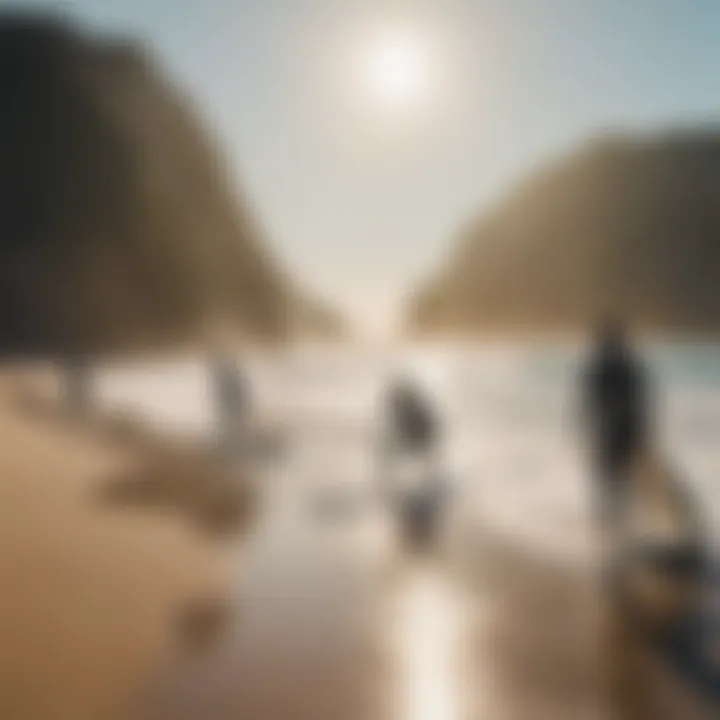
Preparing for Your First Surf Trip
Embarking on your first surfing trip is a thrilling endeavor that can also feel a bit overwhelming. It’s like stepping into a whole new world where the rhythm of the waves meets the thrill of the ride. Preparing effectively for this adventure can make all the difference between a memorable experience and a stressful one. By taking the time to ensure you have everything sorted, from equipment to mindset, you set yourself up not just for success on the water, but also for enjoyment beyond the surfboards.
Essential Packing List
When you're gearing up for your surfing journey, having the right gear can make all the difference. Below is a comprehensive packing list to help you get started:
- Surfboard: Depending on your skill level, a soft-top board is often the safest choice for beginners. They’re easier to ride and less likely to hurt you.
- Wetsuit: The right thickness depends on where you'll be surfing. A 3/2mm wetsuit is usually sufficient for most temperate waters. Make sure it fits snugly.
- Leash: This keeps your board attached to you. It’s crucial for safety; even the best surfers lose their boards sometimes.
- Surf Wax: This will help you maintain grip on your board. Different temperatures require different types of wax, so do your homework!
- Rash Guard: This will protect your skin from the sun and board rash, especially if you’re surfing in warmer waters.
- Towel and Change of Clothes: It’s nice to have something comfortable to wear after you hit the waves.
- Sunscreen: Opt for reef-safe options to protect marine life.
- Snacks and Water: You’ll need to keep hydrated and energized, particularly if you’re planning to stay out for a long day.
"Invest in your gear—it's just as much part of the surfing experience as catching the wave itself."
Make sure to double-check these items the night before you leave. Nobody enjoys the panic of forgetting their board when they get to the beach!
Understanding Local Surf Etiquette
Awareness of surf etiquette can streamline your experience as a newly minted surfer, helping you navigate the waves with respect and confidence. Here’s the lowdown on how to behave responsibly:
- Right of Way: If someone is already riding a wave, it’s their wave. You should never paddle to catch a wave that they're already riding.
- Avoid Dropping In: This is when someone catches a wave while another surfer is already on it, and it can lead to accidents or conflict. Wait your turn—patience is key!
- Respect Other Surfers: Greetings and acknowledging fellow surfers is essential. A little nod can go a long way.
- Don’t Snake: This means paddling around another surfer to catch a wave first. It’s considered rude, and you might find yourself on the receiving end of some unwanted glares.
- Be Mindful of Local Rules: Each surf spot can have specific guidelines or preferences; it's wise to observe or ask before jumping in.
Incorporating these etiquette rules into your surfing habits not only boosts your own enjoyment but also enhances the experience for everyone else out there. Surfing is a shared adventure, and respecting those who share the water is vital for safety and community spirit.
As you prepare for this journey, keep in mind that each wave is a lesson, and each trip is an opportunity to grow, both in skill and in spirit.
Potential Challenges and How to Overcome Them
Embarking on a surfing journey is not without its hurdles. For beginners, the excitement of riding the waves can be clouded by challenges, especially when grappling with fear and understanding the physical demands of the sport. This section sheds light on these common hurdles while providing strategies to navigate them effectively, ensuring that novice surfers step out of their comfort zone while remaining safe and empowered.
Dealing with Fear and Anxiety
Fear is a natural response when plunging into any new endeavor, notably one like surfing, where the ocean can seem both vast and unpredictable. For many beginners, the worry about falling off the board or getting swept away can throw a damper on the excitement.
To tackle these feelings, it helps to break the experience into manageable sections. Start by familiarizing yourself with the surf environment. Just standing on the beach, watching the waves, can provide a sense of comfort and confidence. Gradual exposure is key. Instead of jumping into the thick of things, consider taking a short lesson to understand your board and practice paddling in shallow waters.
Engaging with more experienced surfers can also calm nerves. Their stories of persistence and overcoming fear often serve as a morale booster. Keep in mind that fear often diminishes with familiarity. The more you surf, the more you will learn to trust your abilities and the ocean.
Tips for Managing Fear:
- Practice deep breathing techniques: Calming your mind before hitting the waves can help significantly.
- Set small, achievable goals: Focus on mastering one aspect of surfing at a time—like standing on the board for a few seconds—rather than trying to conquer the waves instantly.
- Visualize success: Picture yourself riding a wave smoothly, which can create a positive mindset.
- Surf with friends: Having a buddy can provide support, encouragement, and company in case of a mishap.
"The only thing we have to fear is fear itself." – Franklin D. Roosevelt
Navigating Injuries and Setbacks
Injuries are an unfortunate reality in any sport, and surfing is no exception. Falling off your board, getting hit by your own board, or encountering sharp coral can pose risks to beginners. Understanding how to manage these incidents is crucial not just for physical safety but also for maintaining your mental approach towards surfing.
First, realizing that minor injuries happen to every surfer, even the pros, can help demystify fears. Preparation is everything. Wearing appropriate safety gear, like a leash, along with using a soft-top surfboard, can lower the risk of serious injury. If you're involved in a mishap, taking a brief pause to recover physically and mentally can make a world of difference.
Communication is vital if you get hurt. True friends will understand if you need to take time off. Additionally, knowing when to seek medical attention illustrates self-awareness and promotes long-term health.
Steps to Recover from Setbacks:
- Take proper care of injuries: Apply ice or seek a medical evaluation to ensure minor issues don’t become major concerns.
- Reflect and adjust: Determine what went wrong and plan how to avoid similar mistakes in the future.
- Stay connected with the surf community: Engage in conversations and learn from others’ experiences with injuries or setbacks.
- Shift focus: Embrace other aspects of surfing, like watching videos, reading about techniques, or practicing yoga to maintain physical fitness while recovering.
In closing, understanding and preparing for the challenges of surfing lays the groundwork for a fulfilling experience. Overcoming fear and handling injury setbacks are integral parts of the learning process. With a solid plan and a resilient mindset, beginners can stride confidently onto the sandy shores, not just in hope, but in certainty that the waves are theirs to conquer.
The End: Embracing the Surfing Journey
In the realm of water sports, surfing holds a distinctive allure, especially for those just wading into the surf. This article has delved into the essentials of embarking on this vibrant journey, focusing on the experiences and memories that define it. Embracing the surfing journey means more than just catching waves; it encompasses the friendships built, the local cultures encountered, and the skills developed along the way. Surfing is a holistic experience, transforming not only how you engage with nature but how you perceive challenge and personal growth.
Building Lasting Memories
Surfing is intrinsically linked with creating memories that endure long after the waves have subsided. Picture this: you’re riding a wave for the first time, the salty breeze tousling your hair, and the thrill coursing through your veins. This moment becomes etched in your memory, often shared with fellow surfers, friends, and family.
Memories come from not just achievements, but also the experiences surrounding them. Whether it’s the laughter shared post-surf over a meal at a local beachside café or the sunsets you’ve watched while reflecting on the day’s adventures, these moments weave together a rich tapestry of your surfing saga.
As you embark on your surfing adventures, look for opportunities to document these experiences. A casual journal or even a social media post can serve as a vessel for these cherished snapshots of life. Every trip to the ocean can turn into a collection of unforgettable tales, solidifying bonds with those who share your passion.
"The waves may wash away footprints, but they cannot erase the memories made."
The Ongoing Pursuit of Skill Development
While capturing memories is crucial, the evolution of your surfing skills is what truly enhances your journey. Surfing is not a skill mastered overnight; it takes consistent dedication and practice. Embracing this ongoing pursuit can foster a sense of patience and resilience that transcends the water.
Many beginners face initial challenges—balancing on the board, choosing the right wave, dealing with wipeouts. Each hurdle serves as an invaluable lesson that not only hones your surfing abilities but shapes your character. Consider seeking feedback from instructors or more experienced surfers. Engaging with local surf schools can greatly aid this development, offering tailored advice and structured progression aimed at elevating your skills.
As you improve, take time to reflect on your journey. Evaluate your progress and set new goals, whether that’s mastering a specific maneuver or tackling more challenging surf conditions. Each step taken enhances not just your competence in the water but also your confidence on land. The excitement of continually reaching new heights creates an enriching cycle of growth and discovery.















